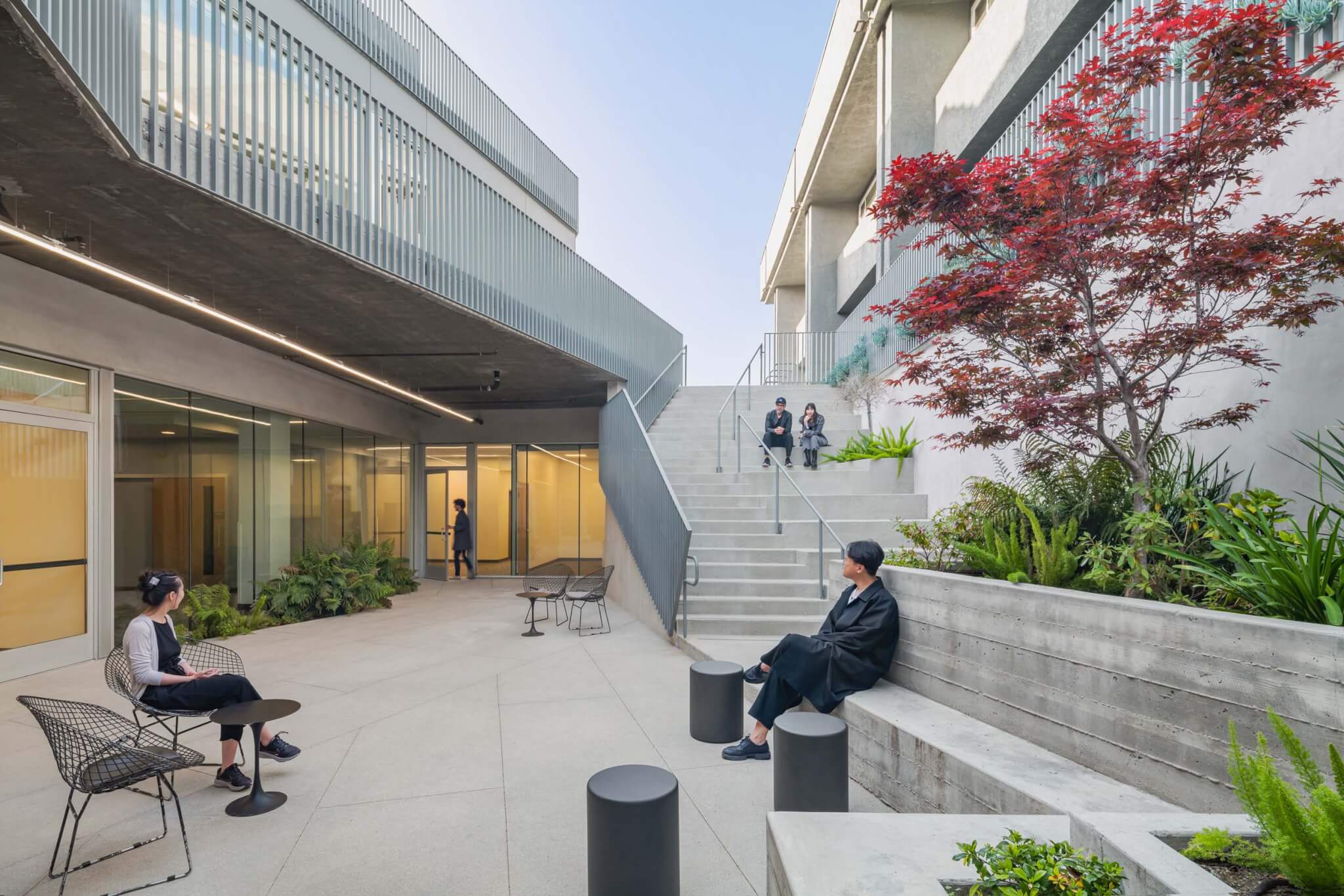Victory Boulevard cuts a straight line through the suburban San Fernando Valley. It’s a 20th-century time capsule: a wide swath of asphalt lined by lowrise retail, gas stations, and fast food outlets that sprung up after acres of orange groves were bulldozed. More recently, infill housing has sporadically plugged in the gaps between strip malls and midcentury apartment buildings, but as a place, the Valley’s commercial corridor is bleak and sunbaked, even on a winter day.
Victory Wellness Center sits within this context, on a banal stretch in North Hollywood. Georgina Huljich and Marcelo Spina of Los Angeles–based PATTERNS transformed a vintage supermarket and “Valley Brutalist” office building (think thick, beige stucco and tinted glass) into a medical campus that is in dialogue with what passes for urbanism in these parts. With a few formal gestures—some slicing and carving out of the existing market structure—their design suggests ways in which outmoded vernacular might be adapted for 20th-century realities.

“In terms of climate and sustainability, the best thing you can do with a building is keep it,” Spina explained. Indeed, the retrofit is strategic in its moves and use of resources. The architects did little more than freshen up the existing office building with a new paint job in shades of gray, focusing their attention instead on adaptive reuse of the older building and a new 10,000-square-foot courtyard. That green space is a kind of front door for the campus. Populated with trees, planters, and places to sit, it not only connects the two structures but also visually links Victory Boulevard to the parking lot behind, where most visitors arrive.
The existing 17,000-square-foot building had a dramatic bowstring truss, brick perimeter walls, and a tall sign tower that once announced “Valley Food Market” to the boulevard. “We wanted to keep the original sign, which is kind of like a minaret, to keep the feel of the neighborhood,” said Spina. “In my mind, this gives a civic meaning to something that was obviously not a civic building.”

PATTERNS retained these elements that give the design authentic character; however, it manipulated them to conform to its own visual vocabulary and increased the square footage to 42,000. In doing so, the architecture subtlety shifts from decorated shed to duck—an uncanny object.
Huljich and Spina pulled back the roof line like a doctor opening a rib cage to reach vital organs, exposing a tessellated series of medical offices (designed for more wellness tenants, like therapists or yoga studios), each topped with a standing seam metal roof and skylight. At ground level they surgically inserted a glass storefront, which angles away from the courtyard to guide visitors into the lobby. The architects were responsible for only the core and shell and not the tenant interiors, yet suites for elder care, physical therapy, or imaging feel generous and light filled, even in the newly excavated basement. Huljich and Spina carved away the ground plane initially to gain more usable area and to structurally shore up the original masonry with some serious trusses and retaining walls, yet the resulting below-grade courtyards don’t feel like dank afterthoughts.

Along the eastern facade, a concrete stair leads to a lower-level lobby, cutting a triangular whorl out of the ground-level plaza. Terraced and lushly planted with ferns and succulents, it suggests a mini canyon or grotto. To the north, another courtyard is a long rectangle, enclosed on one side by the existing brick facade dripping in hanging vines so that patients might look out at the greenery.
In addition to their own practice, Huljich and Spina are both academics (UCLA and SCI-Arc, respectively), and their architecture is often associated with the discipline’s more formal discourses, so it’s refreshing to see in their built work spaces that can be read as user-centered and atmospheric. These outdoor rooms seem an obvious place where doctors and technicians might sit together for lunch or an informal meeting. They are shady, temperate refuges in the blazing hot San Fernando Valley. “In the courtyard, it’s quite cool and welcoming,” said Spina.

Additionally, if the pandemic offers any architectural lessons, it’s that patios, courtyards, and parking lots are also treatment areas and buffer zones ready to be brought into service—as much a part of medical experience as the exam room. And since we live in a time where crises are multiple and overlapping, PATTERNS’s architecture is a surprising proposition for how to build in an increasingly warming climate. Imagine a Victory Boulevard where the lowrise condition remains more or less the same (a counter position to the tendency to densify upward) and an urban subterranea emerges. In this scenario, adaptive reuse, carving out, and digging down are not simply the makings of a renewed medical campus but also the possible beginning of a new Valley vernacular.
Mimi Zeiger is a Los Angeles–based critic and curator.










